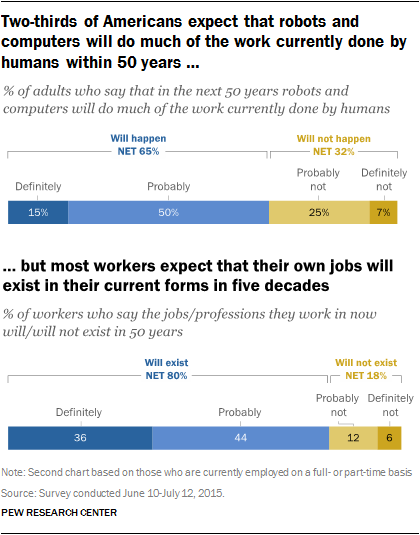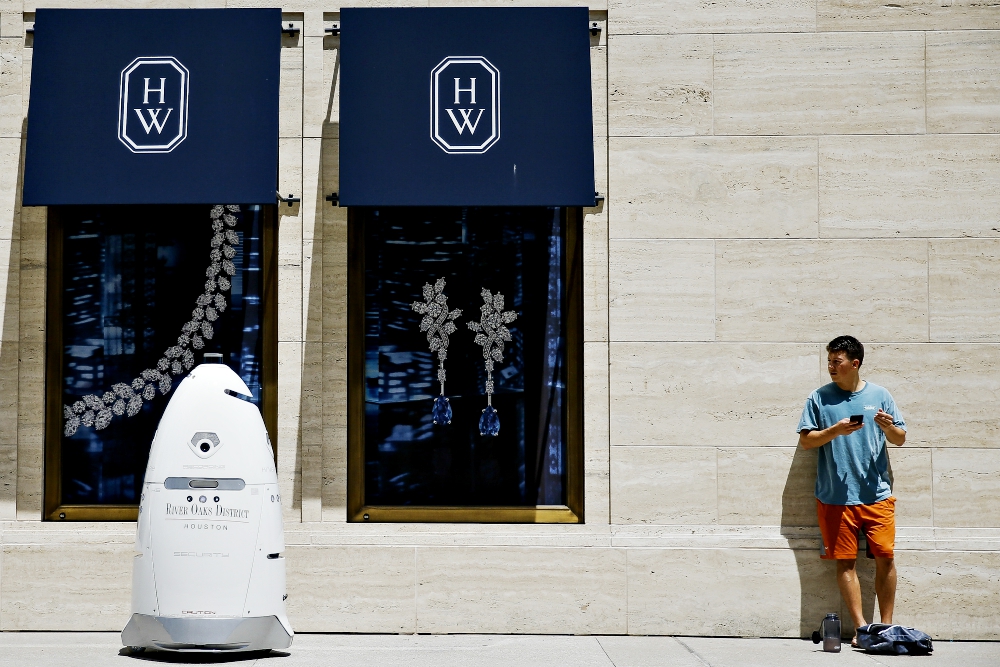
A new security robot drives toward Daniel Webb as it patrols the sidewalks and parking garage of the River Oaks District shopping complex Aug. 18 in Houston. (AP/Houston Chronicle/Michael Ciaglo)
With each robot's successful navigation of the corridors and hallways at Carnegie Mellon University, Manuela Veloso sees in its autonomous movements the future inching its way forward.
"It's not going to disappear ... neither go back," Veloso, director of the Pittsburgh school's Machine Learning Department, said of the artificial intelligence systems empowering the "CoBots" — aka, collaborative robots; picture a roughly 3-foot podium on wheels — to pilot themselves. "It's only going forward."
She was among roughly two dozen participants invited to the Vatican in December 2016 for a two-day workshop hosted by the Pontifical Academy of Sciences on the state of artificial intelligence and machine learning. The technology and artificial intelligence, or AI, behind the CoBots meandering Carnegie Mellon's buildings are a part of the growing systems that are reshaping the world every day in what has been called the fourth industrial revolution.
It is set to change how people live and also how they work.
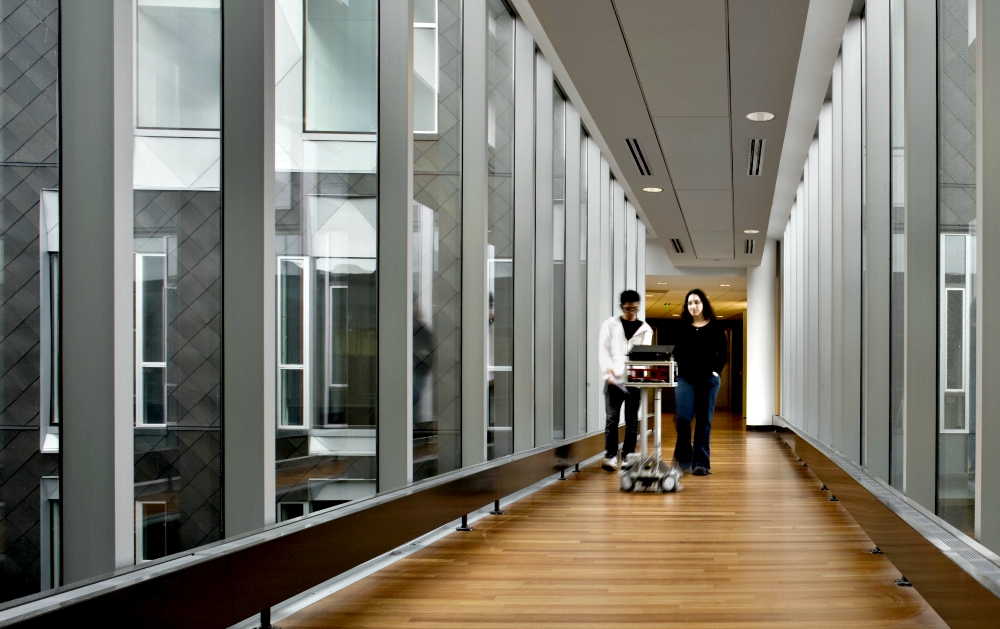
A mobile CoBot, or collaborative robot, leads students across a walkway bridge on the campus of Carnegie Mellon University in Pittsburgh. (Carnegie Mellon University)
Andrew Jordan sees the future coming, too. His hometown of Columbus, Ohio, where he worked as a transit bus operator for 15 years and now serves as president of Transportation Workers Union Local 208, received a Smart Cities grant in June 2016 from the U.S. Department of Transportation. The grant includes funds to implement an autonomous bus line.
The union is not against the technology and is excited about its potential to help manage traffic flow and warn bus operators of accidents or before possible collisions, Jordan emphasized. "We just want to be part of the technology," and a part of the discussion about its implementation.
Just not replaced.
As conversation in the country since the 2016 presidential campaign has centered on jobs — primarily, where they've gone and how to get them back — globalization and immigration have received extensive attention as factors in jobs' disappearance from the American economy. But automation has played as much a role, as more and more factories and businesses employ AI into their workforces, often with the result of fewer workers.
"It's foolhardy to believe that we're going to bring back manufacturing in the mirror image of the jobs that we lost. Automation has had an effect," said Thomas Kochan, co-director of the Institute for Work and Employment Research at the Massachusetts Institute of Technology. "Companies have moved on, and we're not going to see big numbers come back."
Advertisement
Through the Labor Guild, a Boston archdiocese agency, Kochan and other Catholic business leaders have worked to foster labor-management relations from a position of justice and Catholic social teaching, its modern version dating back to Pope Leo XIII's 1891 encyclical Rerum Novarum. Adrian Dominican Sr. Mary Priniski, a past Labor Guild president, said that the church has long defended the dignity of the worker and the right role of work, but it must be straightforward about automation's impact.
"Many fewer jobs are going to be there, and that's just going to be the reality in the future, and we need to be honest about that with workers," she said.
In the U.S. bishops' 2017 Labor Day statement, Bishop Frank Dewane of Venice, Florida, observed, "Today, we are in the midst of a technological revolution, which has coincided with severe economic disparity" that threatens to accelerate in part from automation's growing presence.
"The root of the problem, which remains prominent," Dewane wrote, "comes from an errant understanding that 'human work is solely an instrument of production.' "
As automation and AI become more advanced and widespread, more jobs traditionally done by humans will be eliminated. To what extent, at what pace, in what sectors and what might replace them remain unanswered, though pressing, questions. But just as important, if not more, is the question of how society responds to ensure the benefits of such technological advances reach all people.
Automation accelerating
Thirty-eight percent of U.S. jobs are at risk of automation by the early 2030s, according to a March analysis by consulting firm PricewaterhouseCoopers. Another study from the private nonprofit National Bureau of Economic Research estimated that between 1990 and 2007, each robot introduced into a local workforce eliminated six human jobs. A January report from McKinsey Global Institute projected that fewer than 5 percent of jobs were at risk of full automation, though nearly every occupation could see impacts of some level.
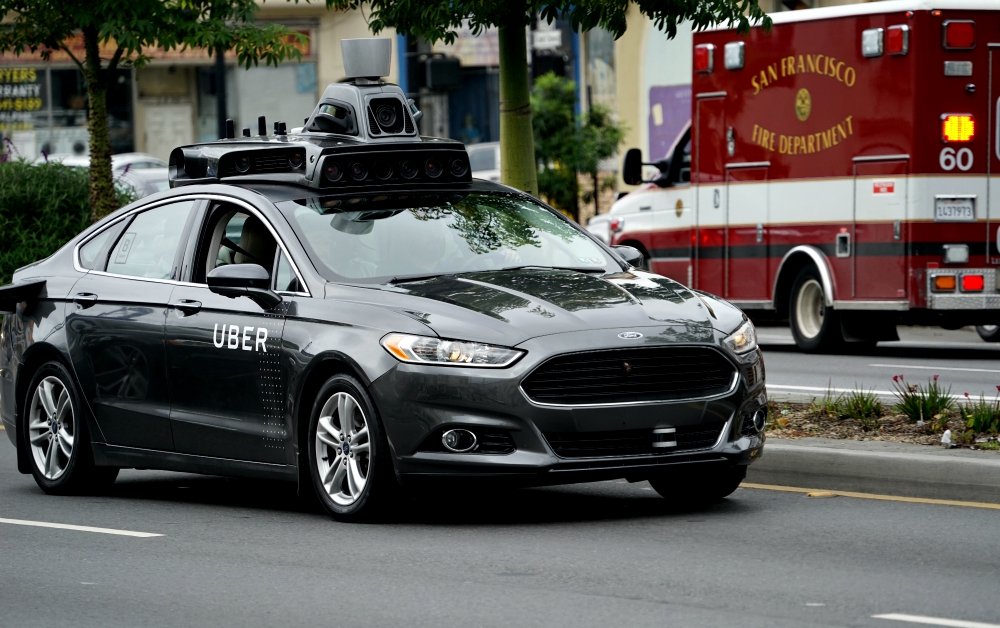
An Uber autonomous vehicle prototype is spotted in San Francisco in November 2016. (Wikimedia Commons/Dllu)
While manufacturing jobs are most commonly associated with robotic replacements of human workers, more and more industries are expected to see increases in automation. The driverless buses being piloted in Columbus are popping up in other U.S. cities. Google, Tesla, Uber and the major automakers are all developing their own fleets of autonomous vehicles, with some models anticipated on the roads by 2020; the U.S. House of Representatives is set to vote next week on a bill that would expedite the deployment of self-driving cars.
Fast-food chains such as McDonald's have begun using automated kiosks in some stores, while grocers and retail stores have employed self-checkout lanes. IBM's Watson is making further inroads into health care. Even in journalism, AI programs for several years have written financial reports and sports recaps.
(This story was written by a real person.)
"The worry, simply put, is that the machines are starting to displace human labor at such a rate that newly created occupations can't keep pace," said Don Howard, a philosophy professor at the University of Notre Dame and former director of its Reilly Center for Science, Technology and Values.
A 2015 Pew Research Center survey found that two-thirds of U.S. adults anticipate robots and computers will do much of the work currently performed by humans in the next 50 years. At the same time, 80 percent of those polled felt their own professions would still exist, and just 11 percent were somewhat concerned about losing their job to a robot. Factors like poor management, industry shrinkage, lack of skills training, and competition from lower-wage workers all ranked as higher concerns.
Past concerns revisited
Anxiety over machines replacing human labor has long been prevalent, dating back as far as Aristotle. The term Luddite — today, typically a derogative term referring to someone who rejects technology — was born from early-19th-century English textile workers who destroyed machines in their mills in attempt to preserve their livelihoods. In American folklore, John Henry famously defeated the steam-powered drill in a railroad spike-driving contest, but died of exhaustion as a result.
In the late 1920s and '30s, the introduction of mass production and assembly lines sparked fears about the future of jobs, exacerbated more so by the Great Depression.
The introduction of robotics into the automotive assembly line in the 1960s brought a new wave of robophobia, followed by fears from personal computers in the '80s.
"In some ways we are experiencing a debate and a set of concerns we've experienced before in the past," said Joseph McCartin, a history professor at Georgetown University and director of its Kalmanovitz Initiative for Labor and the Working Poor.
The recurrent fears of widespread technological unemployment that accompanied each major shift in the economy — from agrarian, to industrial, to service — mostly subsided, with some jobs indeed disappearing while new ones were created, he said.
Though that pattern has held in the past, that doesn't mean it will continue, McCartin added. He sees the scale and scope of changes in the economy due to automation today as "simply just much larger" and capable of a much greater impact. In particular, he worries about the impact of automation — whether it's Amazon's delivery drones, or Uber's and Domino's driverless delivery of passengers and pizzas — on the 3.1 million professional drivers in the transportation sector.
A promotional video demonstrates Amazon's drone delivery. (YouTube/Amazon Prime Air)
Kelly Ross, deputy director of the AFL-CIO legislative and policy department, said the labor movement has been dealing with automation for 200-plus years, "so it's a continuing issue."
"And our general view on this is that technology is a good thing, and making workers more productive is a good thing, because that's how you get higher wages," he said.
The primary question, as he see it, is not whether technology will progress further into the workplace but rather who's going to benefit, specifically in terms of economic and income growth, from the expected increases in productivity.
"We don't know exactly what the magnitude's going to be, but it could be substantial. And we need to start thinking about what this means for working people and how we put in place structures to make sure that this is a good thing and not a bad thing," he said.
McCartin, a board member for the Catholic Labor Network, added, "We don't want an economy that inhibits innovation, but we don't want an economy, either, in which innovation runs roughshod and without direction and is implemented in a way that is potentially devastating to the economic security of millions upon millions of workers."
Life in the 'technocratic paradigm'
Pope Francis, in his 2015 encyclical on the environment, "Laudato Si', on Care for Our Common Home," addressed technology in a chapter on integral ecology.
He acknowledged it has improved the quality of human life and "has remedied countless evils that used to harm and limit human beings." But the pope also condemned a "technocratic paradigm" in society that he said "accepts every advance in technology with a view to profit, without concern for its potentially negative impact on human beings" and where "life gradually becomes a surrender to situations conditioned by technology, itself viewed as the principal key to the meaning of existence."
"Nobody is suggesting a return to the Stone Age, but we do need to slow down and look at reality in a different way, to appropriate the positive and sustainable progress which has been made, but also to recover the values and the great goals swept away by our unrestrained delusions of grandeur," Francis wrote.
On automation's impact on labor, the pope was blunt: "We were created with a vocation to work. The goal should not be that technological progress increasingly replace human work, for this would be detrimental to humanity. ... To stop investing in people, in order to gain greater short-term financial gain, is bad business for society."
A technologically advanced economy that reduces production costs by replacing workers with robots presents "yet another way in which we can end up working against ourselves," he said.
Francis reinforced the church's long-held view of work, that it is a necessary "part of the meaning of life, a path to growth, human development and personal fulfillment," and a way for humanity to participate as co-creators in God's creation.
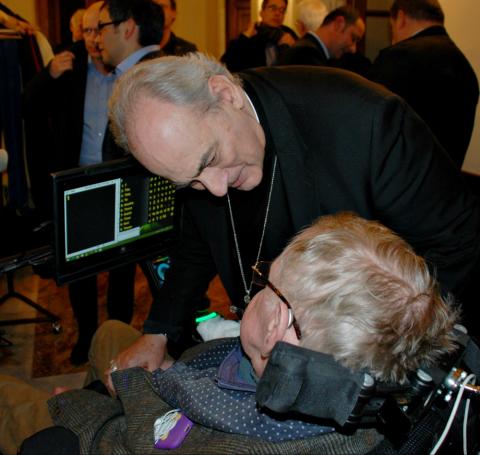
Bishop Marcelo Sánchez Sorondo, chancellor of the Pontifical Academy of Sciences, talks with physicist Stephen Hawking Nov. 30, 2016, during a break at a Vatican-sponsored conference on the power and limitations of artificial intelligence. (Pontifical Academy of Sciences)
"Developing the created world in a prudent way is the best way of caring for it, as this means that we ourselves become the instrument used by God to bring out the potential which he himself inscribed in things," the pope wrote.
At the conclusion of Vatican AI workshop in December, the participants in a final statement acknowledged the potential of AI "to advance every area of science in society," along with the likelihood that income and knowledge gaps will only widen as more and more jobs are lost to computerized devices.
"Unless channeled for public benefit, AI will soon raise important concerns for the economy," they wrote.
In his own presentation at the meeting, renowned physicist Stephen Hawking gave a view he has repeatedly stated: "AI will be either the best or the worst thing ever to happen to humanity. We do not yet know which."
Rebuilding the social contract
Given the prominent role labor has for centuries played for people in how they view themselves and their self-worth, the loss of work raises not just economic concerns but psychological and moral ones, as well, said Howard, the Notre Dame philosopher.
"What happens to human personhood? What happens to the way people value themselves and think about the kind of human beings they are?"
Veloso, a former president of the Association for the Advancement of Artificial Intelligence, told NCR that AI researchers are increasingly focused on ensuring the technology is of benefit to society, but stressed such conversations are in the beginning stages and only starting to extend into interdisciplinary circles. Her time, for now, is spent more on the technology itself, such as keeping the CoBots from running into walls.
"We are in a level of technicality much, much, much lower than thinking about all these big problems," she said.
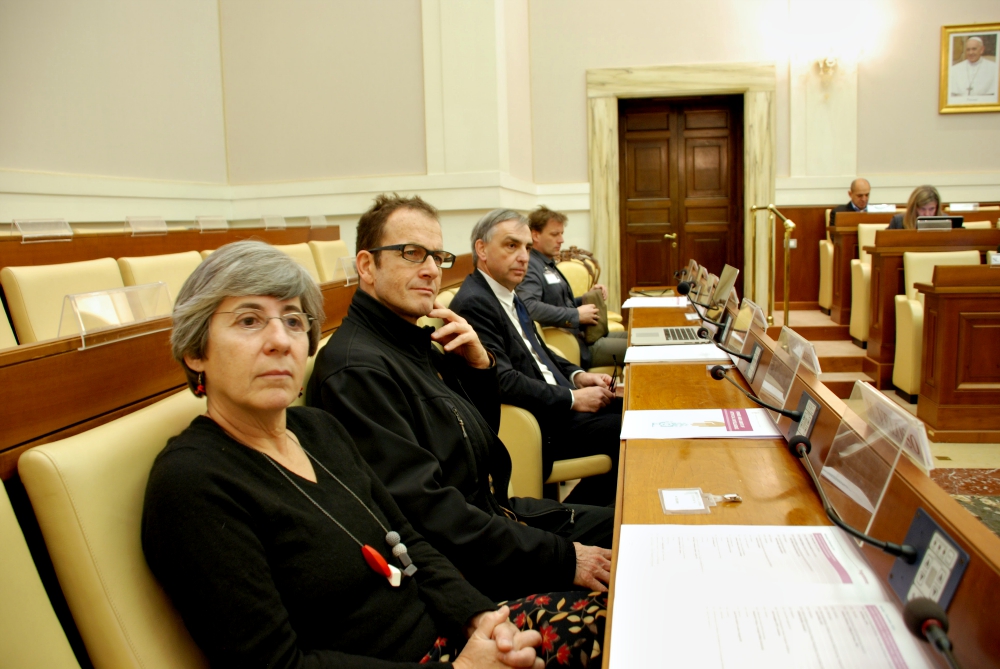
Manuela Veloso, left, head of the Machine Learning Department at Carnegie Mellon, listens during a workshop titled "Power and Limitations to Artificial Intelligence" held at the Pontifical Academy of Sciences Nov. 30-Dec. 1, 2016. (Pontifical Academy of Sciences)
Unapologetically optimistic about AI's prospects, Veloso, who is Catholic, anticipates too a forthcoming disruption of the work world, but, from her view, she can see how one new robot, say one that cleans your house, can spur a multitude of new careers. "The concern for me is more the transition. It's not that there will be no jobs for humans. I think it's the opposite."
Kochan, the MIT George Maverick Bunker Professor of Management and author of Shaping the Future of Work, believes that addressing the future of work begins with not leaving solutions to the AI developers but including stakeholders across society, in particular workers and the technology users.
Workers, he argues, should have a voice in how new tech is implemented into work systems, be trained on how to use it and in the new skills required to apply it, and should receive help in retraining if their positions are ultimately eliminated.
"We have to make that [strategy] the norm, not the exception in industry today," he said.
Historically, increases in productivity have been accompanied by wage growth. Following the Second World War, a period of tremendous technological progress, the greatest gains in income were concentrated among the poor and middle classes, but since 1980 that pattern has reversed, with most of the raises going to the rich.
Ross with the AFL-CIO attributed the post-World War II gains in part to strong unions and a policy of full employment.
"Despite all that disruption, you had very strong wage growth; working people were benefiting from this for decades. And that just goes to prove that technological progress does not determine a result that's bad for workers. It's the policies that go with it," he said.
The No. 1 challenge Kochan sees for employment relations today comes from a core aspect of Catholic social teaching, in rebuilding a social contract currently in tatters into one that works in today's world.
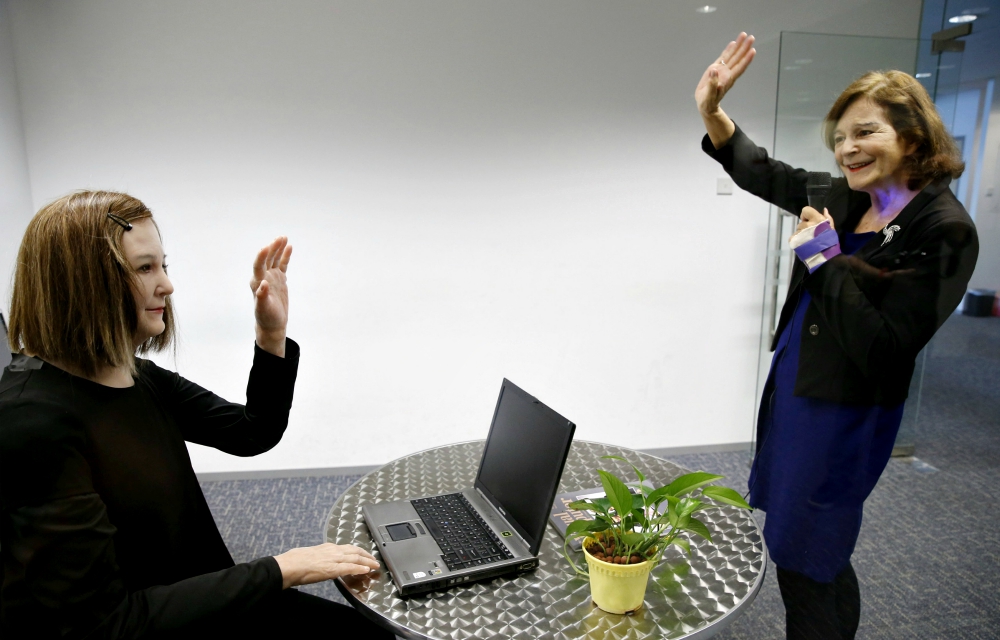
Nadia Thalmann, right, a professor at Nanyang Technological University in Singapore, talks to a humanoid robot March 1, 2016, that she and her team created. With her brown hair, soft skin and expressive face, the humanoid is a new brand of robot that could one day, scientists hope, be used as a personal assistant or care provider for the elderly. (CNS/Reuters/Edgar Su)
"It's certainly an economic issue, but it's also a deeply moral issue," he said. "If we don't have the kind of sense of solidarity in the best tradition of that term, that we look for the common good, then we're not being responsible citizens and we're not engaging in the kind of moral leadership that we expect in society."
Francis engaging these questions, and encouraging others to do so, is a good start, Howard said.
"As a nation, as local communities, as a global community, we have to be asking questions about what we take to be the good life, what form of life do we want to be living, and how can we integrate ever-more-sophisticated technologies into our lives that support our achieving a kind of good life we all would like to live," he said.
McCartin said those conversations require serious thought about shared priorities "in the ways that Pope Francis has argued for, that is, that the economy has to exist for people, not people for the economy."
Searching for solutions
Gatherings like those held in Rome are an important way for the Catholic Church to engage issues around technology and work, said Priniski, who in May 2016 attended a forum hosted by the Pontifical Council for Justice and Peace on sustainable development and the future of work.
"We hold up the principles," she said. "We don't have the solutions; that's not our job. We have the moral voice. But you can pull people together to think about it," she said.
The Dominican sister, involved in labor issues since the late 1970s, said such organizations could bring together businesspeople, workers, academics and those developing AI systems to seek solutions and pathways to ensure the technology serves society as well as meaningful work for all. Bishops, too, could convene such gatherings, she added.
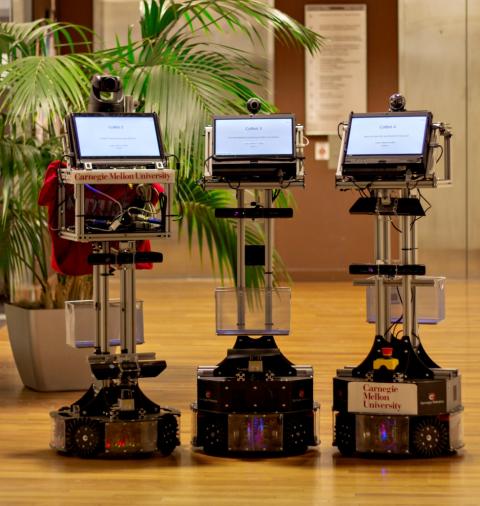
Three of the autonomous mobile CoBots developed at Carnegie Mellon University (Carnegie Mellon University)
Solutions floated to address the coming workforce disruption run the gamut. Retraining and education programs, whether funded by companies or government, are a common proposition. Tesla CEO and SpaceX founder Elon Musk is among those calling for government officials to proactively regulate artificial intelligence, sharing Hawking's view that without it the technology poses "a fundamental risk to the existence of civilization."
Shortening the workweek again, as done during the Depression through the Fair Labor Standards Act (and backed by Catholic leaders, including labor priest Msgr. John Ryan), could be one way to ensure a wider distribution of jobs even if fewer positions do exist.
A controversial idea is the establishment of a universal basic income, in which every person receives some guaranteed level of pay to meet basic needs. Apart from whether the economy could support such a system, questions arise about whether people would feel free to pursue more meaningful work or lose the motivation to ever get out of bed, Howard said.
Regardless of what approaches are taken, remaining passive is not an option, Kochan said. "Then the worst scenario will play out and we'll just see more of a gap between the winners and losers in the economy as a result."
In Columbus, as the autonomous bus route project enters its pilot phase, the local transportation union president Jordan has questions about how the futuristic motor coaches will fully replace the human drivers who currently operate them. How will a driverless bus help a person with a disability to get on or off? Or offer assistance to a lost or confused passenger? What about the "transit on watch" program, where drivers routinely call in accidents or robberies they witness, at times intervening themselves? And what about the person running behind trying to catch a critical ride?
"If you're a few steps away, an autonomous bus is not going to wait for you," Jordan said. "The human element will wait for you."
[Brian Roewe is an NCR staff writer. His email address is broewe@ncronline.org. Follow him on Twitter: @BrianRoewe.]

